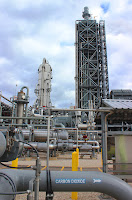In a world with thousands of coal-fired power plants, nearly 2 billion cars and trucks, and billions of tons of coal, oil, and natural gas mined and combusted, it is no surprise that some 40 billion metric tons of CO2 are discharged into the atmosphere annually.
The oceans and the world’s plants absorb some, yet concentrations of CO2 in the atmosphere inexorably rise year by year, climbing in 2016 past 400 parts per million, compared to 280 before the Industrial Revolution. This is setting off changes from a meltdown in the Arctic, to thawing glaciers worldwide, to weird weather and rising seas. Indeed, the atmosphere has now accumulated enough CO2 to stave off the next ice age for millennia, and every person on Earth now breathes air unlike that inhaled by any previous member of our species, Homo sapiens.
To have any hope of slowing such pollution and, ultimately, reversing it, will require an energy revolution and some game-changing technological breakthroughs. After all, it took the advent of cheap methods to fracture underground shale rock with high-pressure water and sand — the technique known as fracking — to free natural gas and make it cheap enough to begin to kill coal in the U.S. As a result of this cheap natural gas freed by fracking, U.S. emissions of CO2 are now back down to levels last seen in the last decade of the 20th century. Of course, natural gas is still a fossil fuel and fracking generates sizable leaks of methane, a potent greenhouse gas. So even though fracked natural gas is an improvement over coal, it still adds to the relentless buildup of CO2.
The key question is: Can engineers and entrepreneurs invent and deploy enough technologies — and the world’s governments adopt the right incentives and policies to eliminate carbon from the global economy — all in time to avert major upheaval from climate change? Already, technological advances are making clean energy sources such as solar and wind more efficient and cheaper, leading to steady growth in their deployment. But renewable energy increases are still being outrun by even-faster increases in fossil fuel consumption as the economies of developing nations like China and India grow and developed nations, such as the U.S., do far too little to wean themselves off oil, coal, and natural gas.
This lack of progress underscores the urgent need for technological innovations, although deploying technologies at the scale needed to significantly slow climate change will require major government expenditures and, hence, a massive dose of global will that has so far been lacking. Some of these technologies may not even be on the horizon, but one tool that many experts say will have to be used is the removal of CO2 from the atmosphere.
Read more at How Far Can Technology Go to Stave Off Climate Change?

Climate Mitigation Engineering: possibly new approach
ReplyDeleteHello,
I would like to know if anyone is working on using ocean plankton to mitigate Climate Change using Emiliania huxleyi? It is the single biggest source of Oxygen on Earth. Eats Carbon like there is no tomorrow, and at the rate Methane is dissociating in the Artic there may not be one for kids under 12.
Is it feasible to select and drain appropriate swamps or lakes in the Artic areas and lay pipe or cannels to bring in sea/ocean water? The latitude would of course be important. The plankton may prove to be the most cost effective way to reduce atmospheric Carbon.
To paraphrase Bill Gates, we need to consider every option.
Windsor ON CA
226-788-5548
Thanks,
Jeff
Climate Mitigation Engineering: possibly new approach
ReplyDeleteHello,
I would like to know if anyone is working on using ocean plankton to mitigate Climate Change using Emiliania huxleyi? It is the single biggest source of Oxygen on Earth. Eats Carbon like there is no tomorrow, and at the rate Methane is dissociating in the Artic there may not be one for kids under 12.
Is it feasible to select and drain appropriate swamps or lakes in the Artic areas and lay pipe or cannels to bring in sea/ocean water? The latitude would of course be important. The plankton may prove to be the most cost effective way to reduce atmospheric Carbon.
To paraphrase Bill Gates, we need to consider every option.
Windsor ON CA
226-788-5548
Thanks,
Jeff